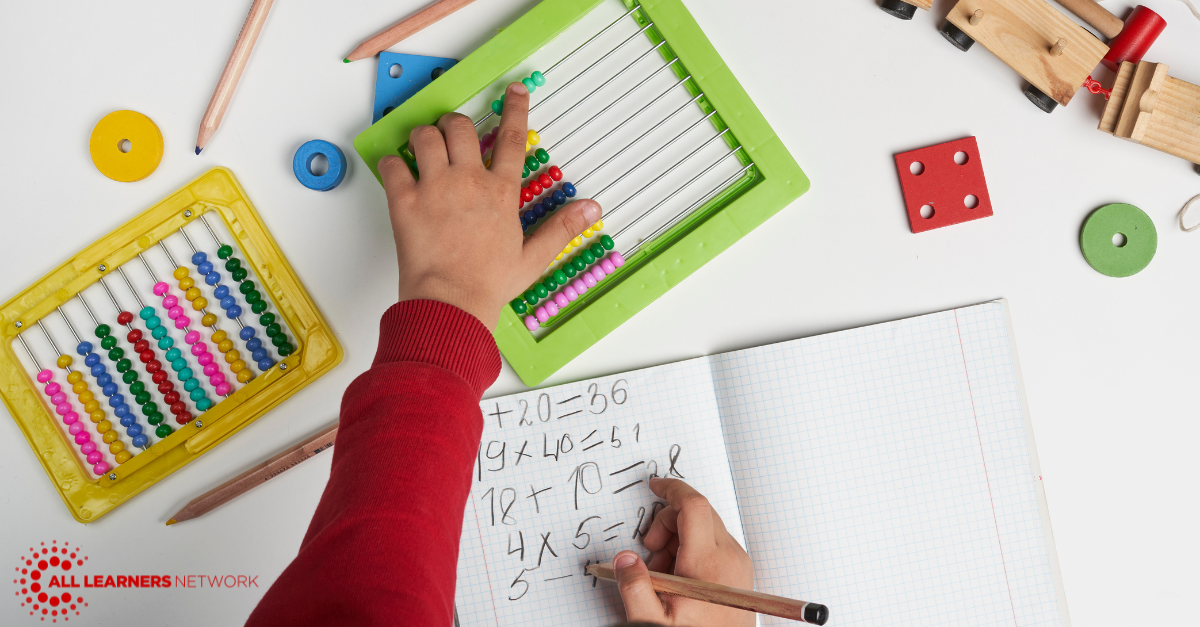
Why Concrete Tools Matter in ALL Math Classrooms
Concrete tools (manipulatives) support access, equity, universal design and differentiation in every math classroom. Manipulatives support mathematical connections and deep understanding. So why are they missing in so many math classrooms, especially in the older grades? The use of math manipulatives provides hands-on access to all students where quantity is observable and abstract concepts contextualized, creating a more inclusive math classroom.
Concrete tools are one of three essential models that support deep conceptual understanding, along with representational models (tallies, drawings, ten frames) and abstract models (equations, numbers, symbols). Students should have many diverse experiences to interweave these three types of models over time. Everyday students and educators should grapple with and utilize the math tools that will support thinking and understanding. Students should have the right to choose between and implement these math manipulatives in all math inquiries.
These three different types of models, concrete, representational and abstract, do not exist in isolation, in fact, just the opposite. Concrete tools should be used to introduce new conceptual ideas and then it becomes critical for educators to implement instructional moves and facilitate student discourse to support students making connections between all of the different models. Through these connections conceptual understanding can be reached. In addition to student discourse, connections are made through transitional tools that further support the relationship between the models. For example, a student can begin to organize their concrete math counters by situating them within more representational models like ten frames, number lines, and arrays. Students can connect coins to symbolic notation or algebra tiles can connect abstract equations. When students have multiple ways to model strategies, they are more likely to be patient, precise, efficient and flexible problem solvers.
When educators focus on only a few or one model, regardless of what it is, it can be proceduralized. Once this happens, thinking stops and a set of repeatable steps takes its place. A common challenge often plays out when students experience a novel context or situation and the application of the steps no longer works and then they are left with no other tools or strategies to re-engage thinking. You may see this play out in a middle level classroom with fractional understanding. Students may be able to procedurally multiply and divide fractions but then reverse the operations when they encounter them in the context of word problems. This often happens because they have memorized a procedure but no longer intuit or understand how and why the operations work.
Too often educators and students rush to the abstract models, algorithms and tricks for a quick or ‘efficient’ answer. Math is not quick and efficiency is not defined by shortcuts and algorithms. In quickness and tricks learners lose sight of concrete and representational models and the connections between them that illustrate and justify why algorithms and abstractions work. There must be opportunity to build, manipulate and connect concrete and representational ideas before more abstract models are introduced. So often the idea of concrete, representational and abstract modeling are thought of as a linear progression toward efficiency, however; educators and students must think of it more like a three part venn diagram where the connections between models centers around conceptual understanding.
If educators continue to rush into algorithms students will continue to reinforce misconceptions and continue to mimic, losing sight of their number sense and intuition. Recently, I have been part of conversations about this exact idea. Take the expression 12 - 7, a student that rushes to apply a procedure like the standard algorithm will quickly become confused as they will ‘borrow a 10’ only to rewrite the same problem in its place. Confusing, right? Whereas a student who looks at the numbers first, envisions tools or representations, might intuit that 7 is 3 from 10 and 2 more from 12, leading them to the difference being 5. The same can be said for a problem like 398 + 412. Forget about the algorithm. Use intuition. Look at the numbers first. How could I solve it? Instead of ‘carrying and carrying’ couldn’t I just take 2 from 412 and add it to 398 to then solve 400 + 410? This is not to say that algorithms and procedures are bad, they are not. They have their place, but this place is not front and center or the end goal but a part of learning that is grounded in the connections between concrete, representational and abstract models.
These connections also iterate through grade levels. As teachers support connections with students it is essential that they also connect content and tools vertically. All Learners Network offers learning progressions that outline models and critical strategies throughout each grade level, kindergarten through eighth grade, that support the trajectory of concepts and the connections between concrete, representational and abstract modeling. These models include tiles, ten frames, arrays and number lines.
Common Core also highlights key mathematical practices that express the necessity of concrete tools in math classrooms. Specifically, three of the math practices describe students engaging with tools, representations, and symbols: reason abstractly and quantitatively, model with mathematics, and use appropriate tools strategically. These three practices define students’ rights to materials in their math classrooms in order to support sense making, productive struggle, and conceptual understanding.
Some Recommended Math Tools
- Counters (two sided chips, bears, cubes, gems, beans, tiles)
- Bead strings (to 10 and 100)
- Bead/Number Racks (to 20 and 100)
- Dice (pip, numeral, various ranges, number of sides, place value)
- Playing cards (ten frame cards, numeral, standard playing cards, blank cards)
- 10 and 20 frames
- Ten Strips
- Interlocking cubes
- Square color tiles
- Base 10 pieces (can be used as area pieces and for decimals)
- Digi Blocks
- Arrow cards
- Number paths
- Iterated number lines (with and without numbers)
- Fraction tiles
- Algebra tiles
- Geometric figures (pattern blocks, Geometric solids)
- Pan balances




